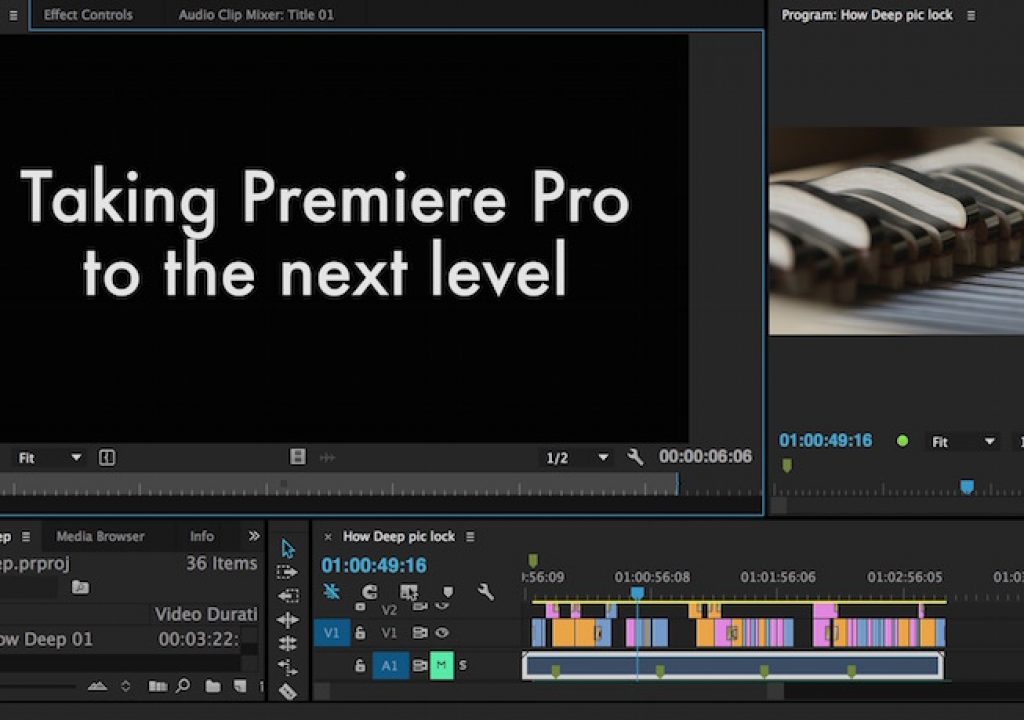At this point in time we are well into the life cycle of the “new” Adobe Premiere Pro. This “new” version is long past the early years of an odd interface, the period where Premiere left the Mac, the rebirth as the CS (Creative Suite), the conversion to CC (Creative Cloud) and the move to a subscription. I’m not sure of Premiere’s actual market penetration but if you keep your eye on the post-production industry these days you know it has made great in-roads in the last few years. But there’s still a few big things that need attention before Premiere Pro can penetrate some of those markets that are still a stronghold for Avid Media Composer.
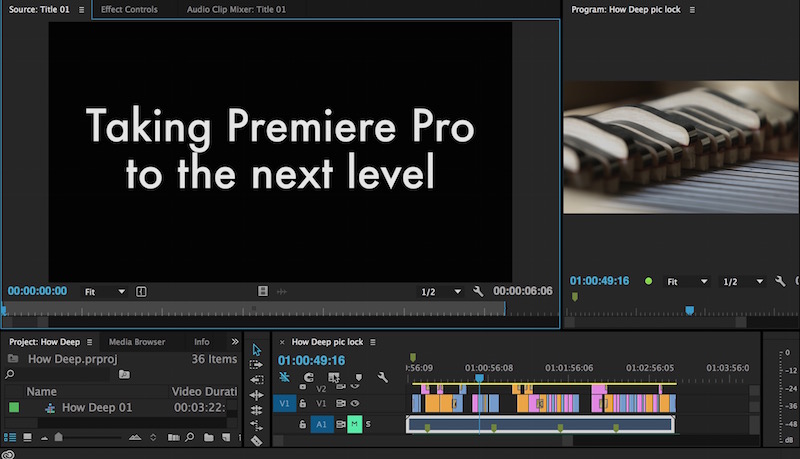
At this point in time we are well into the life cycle of the “new” Adobe Premiere Pro. This “new” version is long past the early years of an odd interface, the period where Premiere left the Mac, the rebirth as the CS (Creative Suite), the conversion to CC (Creative Cloud) and the move to a subscription. I’m not sure of Premiere’s actual market penetration but if you keep your eye on the post-production industry these days you know it has made great in-roads in the last few years. But there’s still a few big things that need attention before Premiere Pro can penetrate some of those markets that are still a stronghold for Avid Media Composer.
While the Premiere Pro toolset is strong with many great features built into and around the NLE there’s a few core things that still need addressing to take PPro to that “next level.” I can’t imagine that all of these things aren’t deep in the planning and/or engineering stages at some form. These aren’t the small features that editors often tweet about wishing that Adobe would add but rather a discussion of changes that would be more deeply integrated tools way beyond a JDI feature. I believe these could take Premiere Pro to that “next level.”
Stability
Stability is perhaps the biggest feature request of all, from every user, in Adobe Premiere Pro or another other NLE. If your editor isn’t stable then it can quickly lead to frustrations, lost work and moving to another platform. Stability is tough as everyone uses their NLE in different ways, on different systems with many different configurations. Yet the NLEs continue to run, often in the weirdest installations. Of all the big 3 NLEs I think it’s safe to say that Adobe Premiere Pro is the least stable. I have incredibly good luck on both of my PPro systems (and most of the client systems I work on) with very few crashes, but it does crash. Compared to both Avid and FCPX, Premiere Pro does crash more often. There are some who say that PPro is unusable in that it crashes so much but I believe those are outlier cases with bad media or a messed up system.
Premiere attempts to minimize losses with a crash. We have a user-set autosave and you can open those autosave projects just like any other project. There’s an option to send an autosave to your Creative Cloud account except that has been broken for many for a long time. Sometimes upon a crash Premiere alerts you that it will “attempt to save your current project.” Upon opening a crash project PPro will even create a copy for you in an attempt to recover it. These are all great things but what would be even better is more stability.
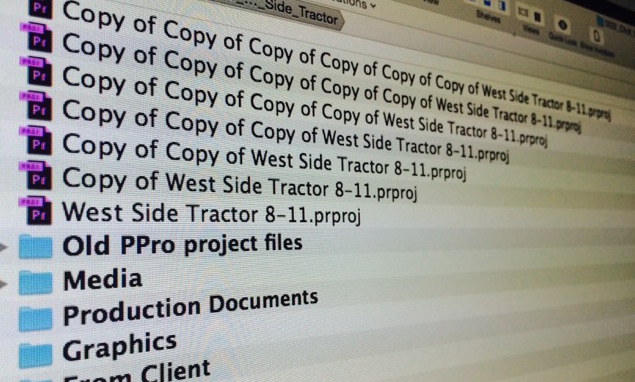
Things shouldn’t get this bad you end up with that many crash projects after a day of editing. Thankfully this isn’t the norm.
I can’t imagine how complex it must be to create a program like Premiere. There’s an endless stream of users constantly suggesting ways to make it better, thousands-millions-billions of lines of code that make it work, a delicate balance of this not breaking that and the wild card of how the user uses it. No NLE will easily handle native iPhone vertical video tossed into their 1080i timeline that is made up mainly of 4K video, random graphics, mp3s and (of course) a lot more H.264s. And yet that’s what many users expect to happen.
Thinking back into post-production software history a bit I seem to remember that both After Effects and Avid Media Composer got a stability cycle at some stage in their development where the engineers focused only on speed and reliability and not on features. While we all want the features we want as soon as possible (I’m just as bad as anyone) a stability phase of development would do all of us Premiere users better in the long run than an amazing new set of features. As long as Premiere has a reputation of being unstable the PPro-haters will always have that to use against it.
As a side note, I was having an conversation with a fellow editor on a recent Avid show we were working on. I had been away from Avid for the most of the year and as I was a few weeks into this job I found myself constantly wishing for features that Avid does not yet have. I’m of the belief that Premiere Pro is currently, overall the most feature rich NLE on the market. My comment was that I would take the crashing of Premiere to get many of the features Avid does not have as even after the crashing I would have a net gain of productivity in the end because of Premiere’s more advanced feature-set. Imagine that if it didn’t crash!
Collaboration
Multiple editors working in a shared storage environment continues to be the stronghold for Avid Media Composer. A properly outfitted network of Avid shared storage (the old Unity or the current ISIS) with lots of seats of Media Composer connected and Interplay running the show continues to cut the majority of films and television that most of us watch. It isn’t fast and it isn’t pretty but it works … and works reliably. No executive has ever been fired for deploying an Avid workflow for their movie.
I have to admit that I have limited experience working deep in a shared Avid workflow where we greatly relied on Avid Interplay. And I’m talking mainly about the Interplay software product that is often the interface that editors see when working in a shared storage environment to retrieve assets and browse projects. Interplay is (I think) more than that but in typical confusing Avid fashion you have to dig in and study to understand it all. To many editors Interplay is just a window to browse and import assets.
Premiere Pro has that ability to browse and import assets right in the interface with the Media Browser. While the Media Browser is where you need to go for proper import of editing assets and camera media it is also the link to collaboration as you can browse inside of other Premiere Pro projects much like you can with Avid Interplay. If all you’re doing with Interplay is using it to retrieve media and sequences that are then copied into your own Avid project then you can do the same thing with the PPro Media Browser. A properly media managed production could utilize dedicated Premiere Pro assist projects as a way to ingest and organize media while that same assist could pull current cuts out of the editor’s project, all via the Media Browser.
Beyond that I’m sure there are some things Interplay adds that the Media Browser does not (like messaging but network connected messing apps are easy to find) but at a basic level a lot of that functionality can be replicated. The overall reliability of Avid-blessed shared storage might be hard to come by but there are a lot of other options like the Facilis Terrablock as well as many turn-key options from Editshare, ProMax and many others. Even Avid’s own shared storage is blessed for Adobe products now. It might seem like a leap of faith to turn a full reality show with multiple editors working all at once over to anything other than Avid but there are those who are doing it.
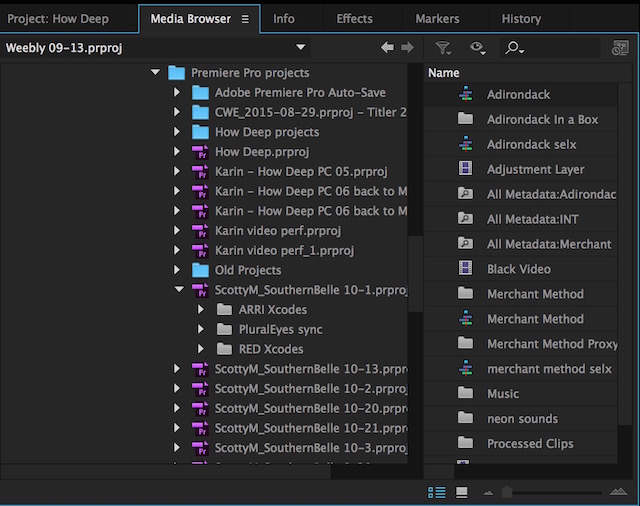
The Media Browser could be the key to seamless collaboration between Adobe Premiere Pro workstations.
Any conversation about collaboration in Premiere must mention Adobe Anywhere which is a “collaborative workflow platform that empowers users of Adobe professional video solutions to work together, using centralized media, across standard networks.” Adobe Anywhere is a very promising future when it comes to collaborative editing and you too can buy one from a reseller. Adobe has sold a number of the installs but at this point in time it’s far from commonplace in the market and asking around I haven’t encountered any editor use it regularly. Beyond the world of Adobe Anywhere it’s those in-house installations using any number of the shared storage options available today that Premiere workflows have to be optimized for if it wants to get more of Avid’s marketshare.
Stability is also an important thing in terms of collaboration as well. I’ll regularly grab edit sequences of completed shows via Avid Interplay from another project and load those into my existing project. They may have hundreds edits and thousands of clips. While Media Composer might pause as it retrieves the assets it never balks at the request or crashes. I have had crashes in PPro while trying to load only moderately complex sequences via the Media Browser. While it certainly works more often than it does not there’s always fingers crosses as I load complex sequences. When I know I no longer have to cross my fingers I’ll know this workflow has arrived.
Easy proxy offline editing mode
We are very quickly moving into a 4K world. Even if you’re not delivering beyond HD (and most aren’t) productions are increasingly shooting 4K which means you either power though cutting at that resolution or your transcode to something else. I don’t like to cut at 4K. Despite all those who say it’s easy there’s still too many dropped frames and too much of a compromise having to playback at 1/2 or 1/4 resolutions. That does not make for a good editing experience.
In this 4K world a modern NLE needs an easy to implement proxy/offline editing workflow. That means the NLE itself can manage the creation of offline media, the tracking of what clips have had proxies created and can easily switch between the two. This has to be an incredibly complex task especially if you’re mixing 5K RED media with a bunch of 1080 stuff but welcome to the world we live in. The NLE that can master this has a leg up.
The NLE that has mastered this thus far is Final Cut Pro X. If Adobe can just replicate this in Premiere we are good to go. If they can best it even better.
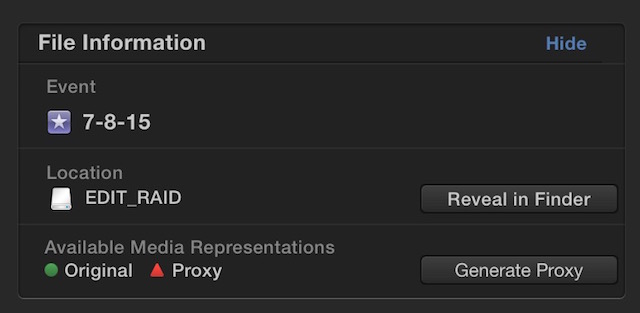
FCPX will manage what media has been created from camera original source files. The Inspector indicates this via little colored icons and allows you to generate proxy clips right from the Inspector. The red triangle means no Proxy media has been generated for that clip.
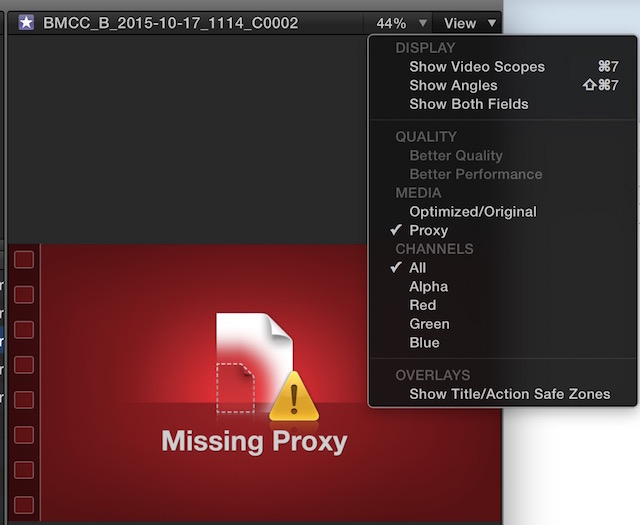
A quick toggle of a switch changes from an offline/proxy workflow to full resolution online. FCPX is smart enough to let you do resizing and work with graphics and keep those scales and positions when moving between the two.
I realize this is probably one of the more complex things you can ask an NLE to do. But I believe this is vital for the future of an NLE. Even with all the GPUs and Thunderbolts in the world, cutting large jobs at full resolution isn’t the best workflow.

DaVinci Resolve has added a proxy workflow as well. In addition to choosing what you’re transcoding to you can change the proxy resolution via the project settings.
A media cache and scratch disk overhaul
There are two kinds of Adobe Premiere Pro CC editors: Those who have had the PPro media cache render gigs upon gigs of cache files to your startup disk and those who will have PPro media cache render gigs upon gigs of cache files to your startup disk.
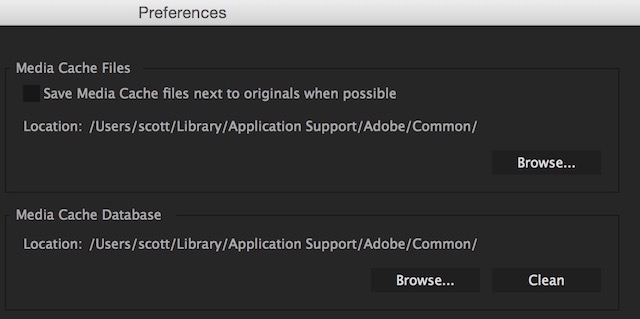
I’d love a preference to never let the media cache end up on the startup disk. I always have a media drive attached.
Let’s not even address the question of why PPro has to write too damn many cache files for things like audio formats it should be able to play back but rather why it defaults to your startup disk and why it won’t warn you first. This is one of the most poorly implemented things in all of Premiere. I realize that PPro might have to write some cache files to even launch and open a project but the system drive should be the last place it wants to write a cache to and it should warn the user when it has no other option. It would also be nice to warn the user when that hidden cache is filling up a startup disk. And while we’re at it PPro should not place that cache deep in the user’s system library but rather out in the open in the Movies folder.
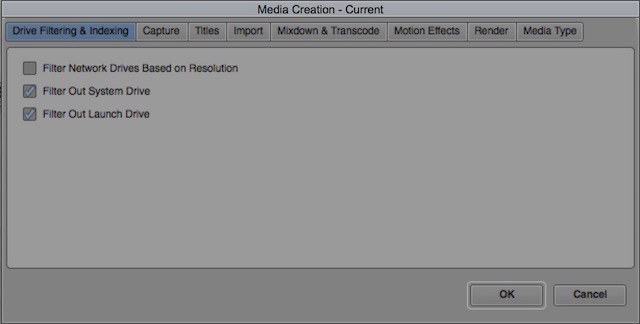
Media Composer has a single clearing house for all media creation. Notice the option to filter out the launch drive.
These are all just a complaints from an editor who has fought the media cache for years. If there’s some valid technical reason (other than it was originally made that way) for the way the media cache is implement I challenge an engineer to explain that in the comments below.
Beyond the media cache Premiere’s Scratch Disks could also use a rethink. Most all editors are aware of a scratch disk’s importance as an NLE often has to write render (and cache!) files. But the current Scratch Disk preference is becoming way too cumbersome for a modern NLE. The new Libraries feature added another option.
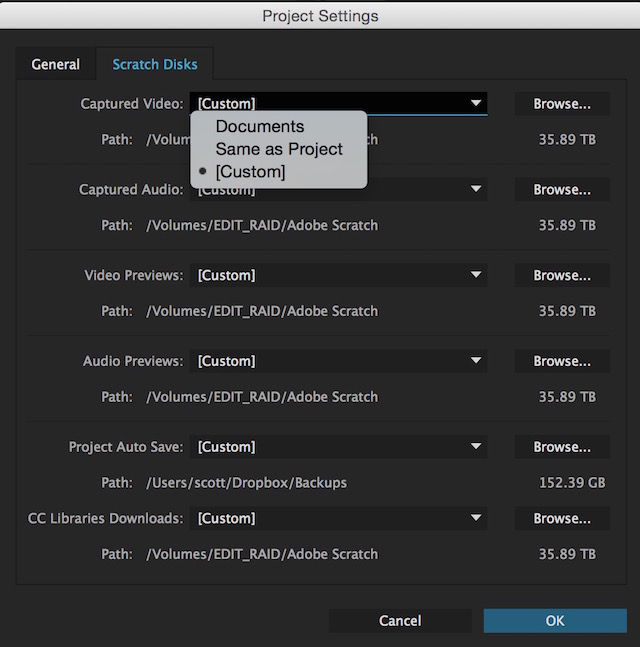
Opening a project might require 5 separate clicks just to even see what is in the project.
I think at the most simple level I’d like to see a once click option to reset all of these scratch disk locations to a single place on my media RAID; a dedicated Adobe Scratch folder. ????? Premiere is smart enough to keep scratch files separated per project so this makes a lot of sense for the dedicated edit system working off of a single RAID.
Just because my PPro project file is placed on drive A that doesn’t mean I want all the scratch disks on drive A. The scratch disk system needs to be smart enough to recognize previous scratch disk locations. It most certainly is not. It would also be great if I could set a default that would be remembered in the location pop-up. If I had a dime for every Adobe Premiere Pro Preview Files folder that I’ve created in the wrong place over the years I’d have my CC subscription paid for the rest of my life. I will freely admit that a lot of that frustration is user error in that I have ended up setting it to the wrong place. But it’s the clunky scratch disk management that has enabled that.
Beyond that it’d be great to see some kind of smart scratching where PPro could recognize when an editor moves a project from one machine to another that already has the scratch disk established for that project. It’s fine to alert me that renders are gone but I’m often baffled as to why the Scratch Disk Settings are popping up yet again. This is going to be incredibly important to manage in a shared storage environment so that gets back to collaboration point above. Many of these improvements can work together.
Control surface hooks into the NLE
This is a small one and doesn’t count in the 4 but it’s a rather glaring omission with the release of the great Lumetri color panel in Premiere. Though Adobe owns Speedgrade and Premiere easily links an edit right into it I think Adobe expects most edits to stay in Premiere for grading. It’s easy to become overwhelmed with the constant clicks and dragging of sliders when you have a long edit to color correct. And with the upcoming Tangent Ripple, an affordable control surface, there are going to be a lot of Premiere users wanting to use this with their NLE’s built-in color correction tools. With the upcoming HDR support I can’t imagine Adobe isn’t thinking about this right now.
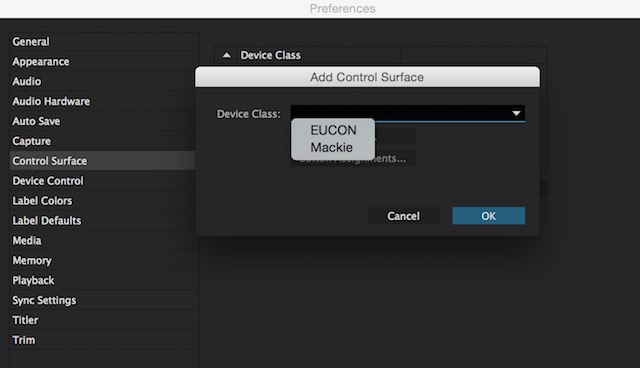
It would be great to see Tangent panels supported directly via the Control Surface preference.
I am a huge fan of Adobe Premiere Pro CC and as a user of all the big three NLEs I believe it currently offers up the deepest overall feature-set coupled with an editing paradigm that can appeal to older editors and newcomers alike. It’s very fast both with hard to edit formats as well as working in and around the interface. Adobe is clearly committed to building a world-class NLE an each update keeps getting better and better. I look forward to what is yet to come.

Filmtools
Filmmakers go-to destination for pre-production, production & post production equipment!
Shop Now